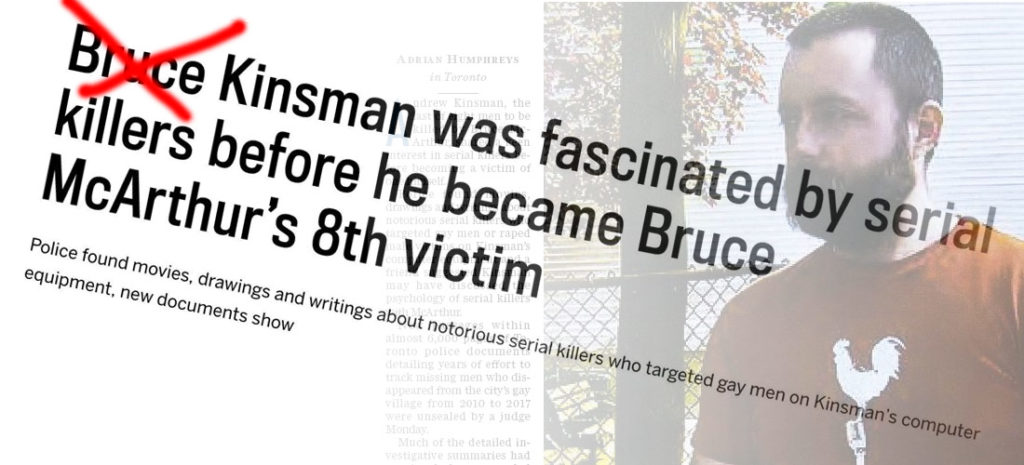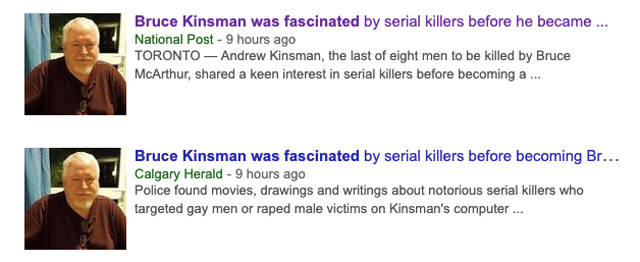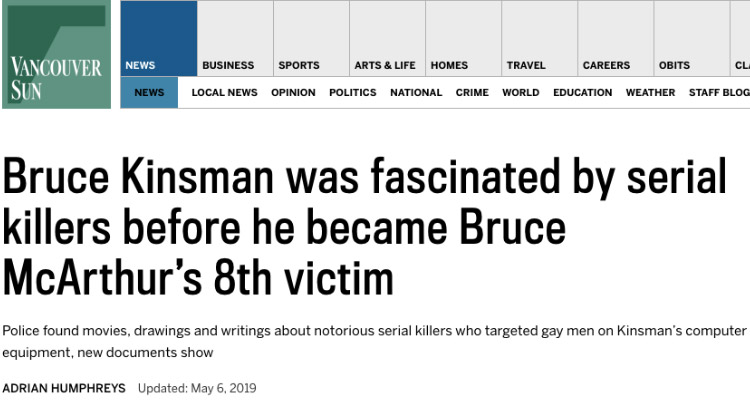
On May 6th, a National Post article by reporter Adrian Humphreys detailed murder victim Andrew Kinsman’s true-crime interest in serial killers John Wayne Gacy and Dennis Andrew Nilsen. In June 2017, 49-year-old Kinsman became serial killer Bruce McArthur’s eighth and final victim, part of a major tragedy that has rocked Toronto’s LGBTQ+ community to the core. True crime is an interest shared by millions of people worldwide, so it seemed strange to emphasize Kinsman’s personal consumption of it in an article detailing his own gruesome death. Furthermore, to write at length about Kinsman’s sexual encounters feeds into a societal narrative about how gay men, through casual sex, are culpable in their own deaths.
For hours, a headline for the same article syndicated across the Postmedia chain read “Bruce Kinsman was fascinated by serial killers before he became Bruce McArthur’s 8th victim,” mixing up the given names of the serial killer and his victim. This poorly copy-edited headline underlined the article’s subtext that Kinsman was a co-conspirator of McArthur and perhaps in part responsible for his tragic death.


Bruce Kinsman was fascinated by serial killers before he became Bruce McArthur’s 8th victim https://t.co/5XFxRs46ph pic.twitter.com/PEx7slWtQN
— Ottawa Citizen (@OttawaCitizen) May 7, 2019
By and large, heterosexual society perceives both the sexuality of gay men and kink as “abnormal.” Kink is often conflated with queerness but isn’t itself inherently queer. Media that services predominantly straight audiences have fixated on McArthur’s interest in casual, rough sex and how he met his victims through dating websites for gay men. Much of the public discourse surrounding these casual encounters has focused on the “abnormal” lives of gay men instead of how to make the world a safer space for them to inhabit.
Humphreys writes that a manager at the Toronto People With AIDS Foundation, where Kinsman volunteered, told police that he said “he had a relationship with a man who, like him, was ‘very into the psychology of serial killers and how they functioned.’” It’s unclear if the man in question was McArthur, but Kinsman did have sexual encounters with him prior to his murder. It’s difficult to know what point sharing this information serves, other than to frame a murder victim as having a stake in his own death. Throughout the AIDS epidemic of the 1980s and 90s, gay men were often blamed for their own deaths when they contracted the virus after engaging in sex with other men. The stigma surrounding men who have sex with men persists today and the latent homophobia present in this article feeds into that narrative. No shared interest in true crime nor casual sex would make one complicit in being murdered by a person they trusted.
Three days prior to this article being published, Netflix released a film entitled Extremely Wicked, Shockingly Evil and Vile. The crime thriller chronicles the relationship between serial killer Ted Bundy (played by Zac Efron), who raped and murdered more than 30 women and girls, and his girlfriend Elizabeth Kendall. Told from the perspective of Kendall, the film plays into the decades-old glorification of white serial killers as handsome, charming, and intelligent.
There is no end to society’s fascination with white serial killers and their grotesque crimes. True crime is a prolific genre that has swept across the podcasting and television worlds, the ethics of which have come under intense scrutiny. There’s the type of true crime that romanticizes physical and sexual violence enacted on helpless victims. There’s also the type that gets audiences thinking critically about corrupting, oppressive forces within the police and justice systems. This Postmedia article resembles the former, focusing on one man’s interest in true crime, an interest shared by many.
On the similarities between McArthur, the man who murdered Kinsman, and Nilsen, a serial killer Kinsman found interesting, Humphreys writes: “Both were seemingly respectable men who preyed on vulnerable gay men, befriending potential victims and luring them to their homes; both men strangled their victims and both dressed and undressed their victims’ dead body before cutting them up.”
What purpose does this comparison serve other than to pathologize Kinsman’s victimhood or to find him partially responsible for his own victimization? Should murder victims’ interest in true crime or casual sex be dissected in articles detailing their horrific deaths? Exempt from this narrative is the portrait of Kinsman as a loyal friend, building superintendent, LGBTQ+ activist, and longtime volunteer at the Toronto People With AIDS Foundation.
Andrew Kinsman’s Facebook profile has been memorialized since his passing but still offers insight into his life. In a recent piece for NOW, I discussed the ethics of web-sleuthing by armchair detectives and how members of a Facebook group called “Serial Killer Bruce McArthur Discuss The Case” dissected Kinsman’s social media presence. Members suggested that Kinsman’s dark humour shone a light on his relationship with McArthur. However, no love of casual sex, true crime, nor amount of dark humour implicates Kinsman as being responsible for his own murder.
Deidre Olsen is a Toronto-based reporter and 2019 Fellow in Global Journalism at the Munk School of Global Affairs and Public Policy.